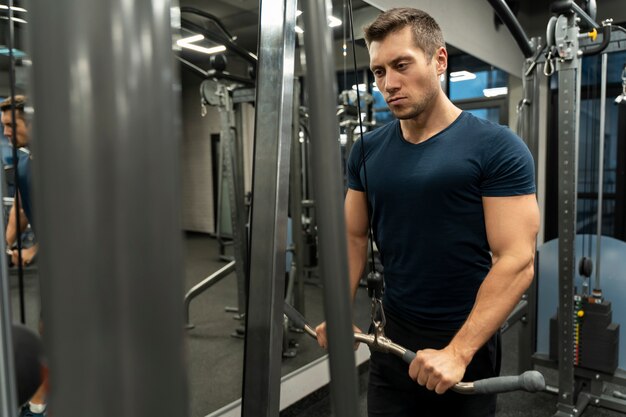The shoulder press machine is a key part of many fitness enthusiasts’ workout routines. It’s designed to primarily work the front shoulder muscles (anterior deltoid), while also engaging the triceps and the trapezius muscles. It even works the upper parts of the chest muscles (pectoralis major) to a lesser extent.
Popular in bodybuilding, this machine is also valuable for general conditioning in various sports and can be a useful variation for strength training.
Understanding the Shoulder Press Machine
A staple in gyms, the shoulder press machine offers several variations, providing an alternative to the traditional barbell or dumbbell military press. One unique variation is the slow forward multipower press, which combines elements of the shoulder press machine and the free military press.
When using the shoulder press machine, you’ll typically be seated, which is more ergonomically friendly for the shoulders. Unlike the rigid stance required for a standard military press, the machine allows for slightly flexed arms, making it accessible for those with limited shoulder mobility.
However, it’s important to recognize the machine鈥檚 limitations. One major drawback is the reduced engagement of stabilizing muscles. Free weight exercises like the dumbbell military press require additional muscle engagement to maintain balance and control, which is less emphasized with machine-based workouts. This could impact overall balance and functional fitness.
Performing the Shoulder Press: A Step-by-Step Guide
Even though it’s performed on an isotonic machine, it’s crucial to manage your scapula correctly and position your humerus head properly. Here鈥檚 how to do it:
1. Adjust the seat height so that at the lowest point, the handle is at collarbone height.
2. Choose the appropriate overhead and sit down.
3. Adopt the correct position: depress and pull together your shoulder blades, lift your chest, and slightly arch your back without overextending.
4. Grip width should align with the outer edges of your shoulders, with no gap between your hand and shoulder when viewed from the front.
5. Inhale deeply to stabilize your core, then press the handles up by fully extending your arms, exhaling towards the end of the movement.
6. Return to the starting position in a controlled manner, keeping your shoulder blades activated throughout.
Types of Shoulder Press Machines
There are mainly two types of shoulder press machines:
1. Machines with free weight loading.
2. Machines with pin-loaded plates and a cable-and-pulley system.
Most machines allow for different grips鈥攚ide, narrow, prone, supine, or neutral鈥攐ffering various muscle stimuli. The grip choice should depend on joint comfort and exercise goals.
Advantages and Disadvantages of the Shoulder Press Machine
The shoulder press machine is great for those with excessive lumbar lordosis as it reduces spinal load and provides uniform tension throughout the range of motion (ROM). However, it may not be comfortable for those with hypolordosis due to lumbar region discomfort. Compared to the barbell or dumbbell military press, this machine provides less functional learning of the vertical push movement and reduced engagement of stabilizing muscles, which can affect maximal strength development.
Common Mistakes to Avoid
When using the shoulder press machine, avoid these common mistakes: incorrect seat adjustment, improper grip, lack of complete scapular activation, incorrect breathing, incomplete ROM in maximum concentricity, sudden accelerations and decelerations, excessive back arching, and losing contact between your buttocks and the seat.
To get the most benefits from the shoulder press machine, ensure you maintain proper form and technique, make the right adjustments, and understand its pros and cons. This machine can be an effective tool for targeting and strengthening your shoulder muscles when used correctly.







